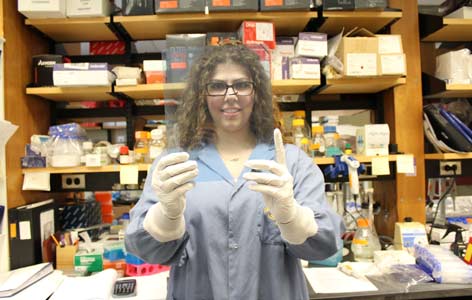Home page Description:
Researchers develop a blood test that identifies patients with a rare genetic disease.
Posted On: January 19, 2017

By Shaalee Dworski, ORT Times Writer and UHN Trainee
Finding the correct treatment for a child with a complex disorder is difficult - it can take many iterations of drug combinations and different therapies to get it right. But what if you are accidentally treating the wrong disease?
Misdiagnosis is unfortunately common, especially when children have rare diseases. Rare diseases are notoriously difficult to diagnose – they are not at the forefront of the physician’s mind, and can be misdiagnosed as a more common disease with a similar phenotype.
Lysosomal storage disorders (LSDs) are a group of more than 50 inherited disorders that are often misdiagnosed. Individually, each disorder ranges from rare to extremely rare, but as a group LSDs are more common; their incidence can be 1:5000 depending on the population.
Techniques to screen patients for rare LSDs would help in the delivery of proper treatments to these patients. The screens could also increase the pool of patients that would be able to contribute to LSD research.
One such rare disease is Farber disease, a rare childhood LSD. Patients with severe Farber disease have joint problems reminiscent of those with arthritis, and may be misdiagnosed as having juvenile idiopathic arthritis (JIA).
Shaalee Dworski, a PhD candidate in Dr. Jeffrey Medin’s laboratory, and colleagues, investigated the ability of blood markers to differentiate between Farber disease and JIA. They found a set of cytokines that were uniquely elevated in the blood of Farber patients. Most of these cytokines returned to baseline in Farber patients that were treated with hematopoietic stem cell transplantation. Importantly, these cytokines were not elevated in JIA patients.
This set of cytokines could be used as a tool to screen JIA patients by blood test and to identify misdiagnosed Farber patients. These patients could get the transplantation that they need and researchers would be able to use the data gathered through the test to better understand the disease and develop more effective treatments.
The original article is available here.
We spoke with the first author, Shaalee Dworski.
1. Are the cytokines that were elevated common to all LSDs?
This set of cytokines was unique to patients with Farber disease, and was not seen in patients with Gaucher or Fabry disease, two other LSDs. Some of the cytokines were also altered in Gaucher disease, but not to the same degree or with the same pattern.
2. Why do you think this set of cytokines are elevated in Farber disease?
A common feature of the cytokines that we found were elevated in Farber patients are that they stimulate macrophage proliferation or migration. Macrophages are a central problem in Farber disease. One of the joint problems seen in patients with Farber disease are subcutaneous nodules that are painful and limit the movement of patients. These nodules are composed of macrophage clusters. Macrophages also accumulate in tissues, disrupting the normal architecture and function of the organs. These cytokines may be stimulating the macrophages to proliferate and migrate into tissues.
3. What are the next steps in your research to advance this basic research finding to impact patient care?
Our ideal next step is to screen JIA patients for Farber disease using this panel alongside the current standards of diagnosis (enzyme assay and gene sequencing). We will also evaluate cytokine-reducing drugs as a possible therapy by investigating whether they can improve the macrophage phenotype in a mouse model of Farber disease.
Finding the correct treatment for a child with a complex disorder is difficult - it can take many iterations of drug combinations and different therapies to get it right. But what if you are accidentally treating the wrong disease?
Misdiagnosis is unfortunately common, especially when children have rare diseases. Rare diseases are notoriously difficult to diagnose – they are not at the forefront of the physician’s mind, and can be misdiagnosed as a more common disease with a similar phenotype.
Lysosomal storage disorders (LSDs) are a group of more than 50 inherited disorders that are often misdiagnosed. Individually, each disorder ranges from rare to extremely rare, but as a group LSDs are more common; their incidence can be 1:5000 depending on the population.
Techniques to screen patients for rare LSDs would help in the delivery of proper treatments to these patients. The screens could also increase the pool of patients that would be able to contribute to LSD research.
One such rare disease is Farber disease, a rare childhood LSD. Patients with severe Farber disease have joint problems reminiscent of those with arthritis, and may be misdiagnosed as having juvenile idiopathic arthritis (JIA).
Shaalee Dworski, a PhD candidate in Dr. Jeffrey Medin’s laboratory, and colleagues, investigated the ability of blood markers to differentiate between Farber disease and JIA. They found a set of cytokines that were uniquely elevated in the blood of Farber patients. Most of these cytokines returned to baseline in Farber patients that were treated with hematopoietic stem cell transplantation. Importantly, these cytokines were not elevated in JIA patients.
This set of cytokines could be used as a tool to screen JIA patients by blood test and to identify misdiagnosed Farber patients. These patients could get the transplantation that they need and researchers would be able to use the data gathered through the test to better understand the disease and develop more effective treatments.
The original article is available here.
We spoke with the first author, Shaalee Dworski.
1. Are the cytokines that were elevated common to all LSDs?
This set of cytokines was unique to patients with Farber disease, and was not seen in patients with Gaucher or Fabry disease, two other LSDs. Some of the cytokines were also altered in Gaucher disease, but not to the same degree or with the same pattern.
2. Why do you think this set of cytokines are elevated in Farber disease?
A common feature of the cytokines that we found were elevated in Farber patients are that they stimulate macrophage proliferation or migration. Macrophages are a central problem in Farber disease. One of the joint problems seen in patients with Farber disease are subcutaneous nodules that are painful and limit the movement of patients. These nodules are composed of macrophage clusters. Macrophages also accumulate in tissues, disrupting the normal architecture and function of the organs. These cytokines may be stimulating the macrophages to proliferate and migrate into tissues.
3. What are the next steps in your research to advance this basic research finding to impact patient care?
Our ideal next step is to screen JIA patients for Farber disease using this panel alongside the current standards of diagnosis (enzyme assay and gene sequencing). We will also evaluate cytokine-reducing drugs as a possible therapy by investigating whether they can improve the macrophage phenotype in a mouse model of Farber disease.

Shaalee Dworski, first author of the article and UHN Trainee.




